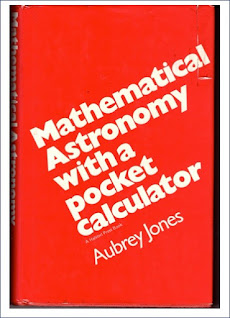I first got interested in celestial mechanics in 1978. I enrolled in three independent study classes at two schools, New Mexico State University, then at Lansing Community College (1981, 1982). In 1981, I met an astronomer from Michigan State University who encouraged me to get this book on algorithms for calculators. He wanted it for himself and I was working for a publisher. So I ordered two. I used the routines as outlines for some BASIC programs but never went much further with it.
[An earlier version of this essay was posted to The Sky Searchers discussion board in the Astrophysics forum.]
 |
| John Wiley and Sons. (c) Aubrey Jones 1978 |
On the one hand, in order to pursue celestial mechanics you really need to love mathematics. As much as I enjoy it, I took Calculus-1 twice to get a C+. I learned integration (usually Calculus-2) by taking a computer programming class and coding up the Midpoint Rule, Simpson’s Rule, and the Trapezoid Rule. The advantage to me is that it is easier to erase a mistake than it is to drive to Home Depot to buy another part (which I have to do to finish work on the backyard gate).
 |
| McCuskey, Addison-Wesley, 1963 |
But if you are not the person launching a satellite to Saturn, why grind through transcendental equations? My reply is the same as for any amateur pursuit, any hobby, or sport: You do it for yourself because it is at once rewarding and edifying. And unlike most other hobbies, astronomy is a study where amateurs and professionals collaborate.
How fast does the Moon go around the Earth?
How fast does the Sun go around the Earth?
How fast do the stars go around the Earth?
And when will that comet come back?
If you have lived any arbitrarily long time, you know that our easy estimates – the Moon travelling through 360 degrees in 28 days; the Sun circling the Earth 360 days each year (plus 5 days for a long holiday "off the books"); the fixed stars moving westward one degree per night through the year -- have errors that accumulate. Can I make more accurate predictions?
Not only has the hard mathematics been done already, reducing the problems to the application of formulae, but I now have a computer and a spreadsheet. All I have to do is take the measurements and reduce the data.
(More later.)
PREVIOUSLY ON NECESSARY FACTS
Astrophotography is a Lot like Love
Measuring Your Universe: Alan Hirshfeld’s Activity and Laboratory Manual
In Support of the Entry-Level Telescope
John Kemeny Knew: We Shall Have Computed
No comments:
Post a Comment
Note: Only a member of this blog may post a comment.